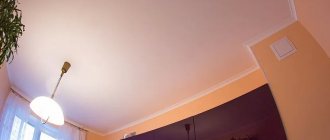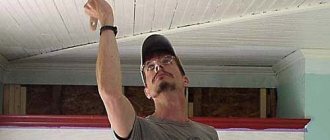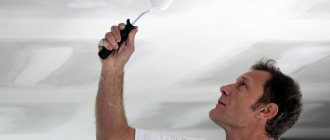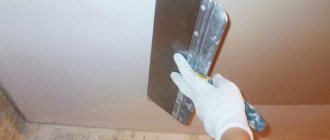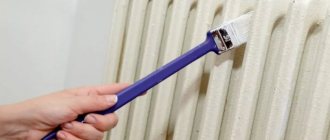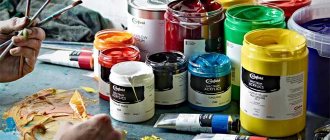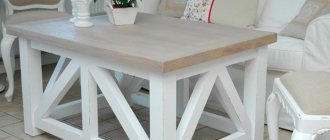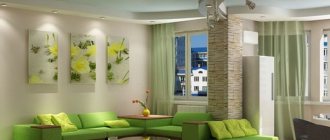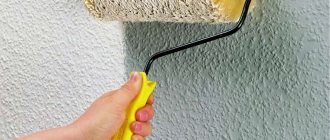One of the most commonly used materials when repairing ceilings is latex paint. It makes it possible to finish the ceiling efficiently and in the shortest possible time. Moreover, it is so easy to apply that even a person without any experience can handle the job.
Latex paint is an emulsion consisting of droplets of pigment, water and binders. Once applied to the surface, the water will evaporate and the binder and pigment will stick together into a single unit. As a result, a thin film is formed on the surface. Both mineral compounds and synthetic resins can be used as a binder. This is a kind of washable paint that makes cleaning much easier.
Latex paint for interior work, washable
Additional Additives
In addition to the main characteristics, it is worth considering the following nuances when choosing paint. If you plan to paint the ceiling in the bathroom, then you should look for a mixture with fungicidal additives to combat mold and fungi. Manufacturers often add various antiseptics to mixtures to protect against all kinds of microorganisms. Thixotropic properties will ensure a more uniform distribution of paint on the surface. Texture additives are used to impart decorative properties to the surface. It is a kind of fine powder that creates a rough surface both to the touch and visually. Manufacturers also add matting additives. However, paints with these impurities will be even less resistant to external influences.
Thixotropy of paints
Conclusion
The analysis presented here of the main characteristics of latex finishing compounds, as well as instructions for their application, will undoubtedly be useful to anyone planning a renovation. And to master the technology, in addition to reading the recommendations, you should also study the video in this article, and then practice a little.
One of the most commonly used materials when repairing ceilings is latex paint. It makes it possible to finish the ceiling efficiently and in the shortest possible time. Moreover, it is so easy to apply that even a person without any experience can handle the job.
Latex paint is an emulsion consisting of droplets of pigment, water and binders. Once applied to the surface, the water will evaporate and the binder and pigment will stick together into a single unit. As a result, a thin film is formed on the surface. Both mineral compounds and synthetic resins can be used as a binder. This is a kind of washable paint that makes cleaning much easier.
Latex paint for interior work, washable
Latex paint
A good choice for finishing the ceiling, but it is not in demand due to its rather high price. At the same time, the cost of the product is justified by many advantages, including: resistance to chips and scratches, moisture, beautiful appearance that lasts for years.
Despite the paint's resistance to the negative effects of paint, when treating ceiling surfaces in bathrooms it is necessary to additionally use a primer with antifungal and antiseptic properties.
The product does not have an unpleasant odor, and the existing one disappears quickly. Moreover, the paint dries in just a few hours and is easy to apply to the surface, which ensures good adhesion to any materials.
Disadvantages of latex paint:
- It is afraid of ultraviolet rays, so it is not recommended to use the paint in rooms under constant exposure to the sun;
- Does not like excessively low temperatures, may become cracked and peel off.
Dyeing process
The work is done very simply, without any special skills or equipment, so even a beginner can do it.
- First, the ceiling (or other surface) must be primed. But if there is no primer mixture, you can immediately cover the surface with a coloring agent (the only thing that must be diluted). You can use ordinary water or special components as a diluent.
- It is best to apply paint using a roller. If necessary, you can use a brush to paint corners and edges.
- Next, the surface must be left until it dries completely.
- The next layer of dye is applied undiluted. You can also use a brush, paint roller or aerosol. To make the paint lay down in a more even layer, you can add a small amount of linseed oil to it.
- After painting is completed, the surface should dry well again. It is important to ensure that there is no draft in the room.
As you can see, painting ceilings with latex paint is not difficult at all. You just need to choose the right material, tools and follow the painting technology.
What to consider when choosing
Ceiling paint differs in its composition components, which determine its properties.
Based on the final textured effect, there are 3 types of ceiling paints:
Matte ceiling paint. It does not have reflective properties, that is, it does not shine. The main advantage of matte compositions is that they mask minor external defects quite well.
Semi-gloss. Has a slight reflective effect.
Glossy. A shiny coating that forms a film that reflects light.
It is important to take into account that the more shiny the ceiling, the more visible minor surface defects are. The ceiling under it must be perfectly flat
The direction of the light also plays a role. If the light bulbs of lamps and chandeliers are directed towards the surface, then the smallest imperfections will be visible. The ceiling is prepared for this type of painting with special care.
There are washable paints that can be cleaned using household products. If there is a mark on the package “resistant to dry abrasion,” then you can only wipe it with a dry cloth. When a hand is passed over such a surface, a light mark will remain on the palm (water-based compositions). In cases where we are talking about ordinary whitewashing, such a surface cannot be washed. Such a ceiling is restored by applying a new composition.
Features of premises and interior
The choice of paint for the ceiling depends on the style of the room and its overall dimensions.
White ceiling paint is most often used in the apartment, and not only because it is a tribute to tradition. White color makes the room visually higher; As they say, ceilings “don’t put pressure.” In a minimalist style apartment, matte finishes are more appropriate.
Related article: Features and types of water-based ceiling paint
Coatings with low performance properties are suitable for painting the ceiling in the living room, dressing room, and bedroom. Washable paint is used in the bathroom, kitchen, and on the veranda of the house. It is advisable that it contains fungicidal additives that prevent the formation of mold.
Paint selection
To choose the ideal latex paint for ceiling decoration, you need to decide not only on its shade. An important parameter is the degree of gloss, which is divided into 6 categories. The lower the gloss number, the more matte the surface will be after drying.
A composition that provides an almost mirror-like finish is extremely rarely chosen, especially for walls. The most popular is considered to be a moderately matte paint.
It is also necessary to take into account parameters such as moisture and wear resistance. You can judge them using the abrasion cycle indicator, which is indicated on each package. The higher the number, the more durable the finish will be. Sometimes this characteristic is indicated in classes, the highest quality of which is the first class.
It is worth paying attention to two more parameters:
- Covering power refers to how much material is required for complete coloring without translucent areas.
- Thixotropy characterizes the rate at which paint thickens after it is applied to the surface. Based on this indicator, we can conclude how great the risk of streak formation is. With low thixotropy, streaks may occur during dyeing.
What is washable latex paint?
Washable latex paint is one of the most environmentally friendly paint and varnish materials on the construction market.
Plus, it has excellent performance characteristics, which makes its use more practical. Previously, we already looked at which paint is best for the floor, but now it’s time to talk about one of the best enamels for walls and ceilings.
Washable latex paint: basic characteristics
Washable latex-based paints are among the most wear-resistant paints and varnishes. Even such fairly popular paints as enamels based on acrylic resin are inferior in this parameter to latex-based paints.
Due to this property, the main area of application of latex paints are public buildings with high traffic, including administrative buildings, hospitals, clinics, educational institutions and so on.
It is important to note that washable latex paint has also found its use in everyday life - most often in the work area in the kitchen and ceilings in the bathroom. Just like acrylic floor paint, latex paints have an increased level of resistance to abrasion and household chemicals, which makes cleaning the walls covered with them a very simple procedure: just use a sponge or soft-bristled brush
Just like acrylic floor paint, latex paints have an increased level of resistance to abrasion and household chemicals, which makes cleaning the walls covered with them a very simple procedure: just use a sponge or soft-bristled brush.
Another important point is the fact that latex washable paint does not allow moisture to pass through and reliably protects the surface from it; this type of paint has a high level of vapor permeability, which allows it to remove excess moisture from the surface, which will protect the room from fungi and mold, although the protective primer The solution should also not be neglected.
The last characteristic of washable latex paint that I would like to talk about is the type of coating.
Unlike most other paints and varnishes, latex washable paints are available in matte, semi-matte and glossy, which allows them to fit into almost any room design, no matter what shape and style it has.
What companies produce latex paints?
The modern market for latex paints has many options for enamels from different manufacturers.
For the most part, they are similar to each other and are based on the basic production technology of this paint and varnish material, but there are still manufacturers who, for one reason or another, are worth paying special attention to:
Belinka washable latex paint. These paints and varnishes are distinguished by the fact that they have one of the lowest prices on the modern construction market: from 420 to 600 rubles per liter, depending on the volume of packaging of the material.
At the same time, they fully meet all the basic properties of latex paints, for which this paint and varnish material is chosen;
Tikkurila latex paint. A special feature of paints and varnishes from this manufacturer is the fact that the company produces a huge range of latex paints for various segments.
Her collection also includes very cheap paints: from 270 rubles per liter, they are suitable only for household use, and very expensive paints: from 700 rubles per liter, which belong to the premium segment and can function perfectly in the most trafficked public places.
Material overview
Paint properties
Latex compositions belong to the category of water-dispersed paints. This means that in addition to the pigment and latex binder, the paint includes water, which acts as a solvent. .
Such mixtures can be used for both external and internal work. This is ensured due to the high strength of the polymerized layer: after complete drying, the latex film becomes inert and can withstand not only systematic moisture, but also mechanical stress.
Container with composition
Note! High-quality material must contain at least 30% film-forming components.
Based on their appearance, the compositions are divided into matte and glossy. Modern technologies make it possible to produce pigments with fairly high (up to 60-65%) gloss levels.
Due to the use of styrene-acrylic components, the adhesion of the material to most substrates is significantly increased. Latex paint can be applied to concrete, brick, plaster, wood, as well as to walls that were previously painted with water-based or alkyd mixtures.
Benefits of latex-based formulations
This material has quite a lot of advantages:
- Firstly, the fully polymerized coating is highly moisture resistant. In addition, if it becomes dirty, it can be easily washed without fear for its integrity.
Advice! When washing, do not use aggressive reagents or hard sponges. If the ceiling gets dirty constantly (for example, above a stove on which intensive cooking takes place), then you should use silicone or silicate paints instead of latex ones.
- Secondly, the applied layer of paint acts as a vapor barrier. This provides waterproofing sufficient to fully protect the base (plaster or drywall).
Photo of textured coating
- The material is easy to apply, has no pungent odor, and dries fairly quickly. Depending on the humidity in the room where finishing is carried out and the thickness of the paint layer, the time between passes should be from 30 minutes to 2 hours.
- The applied material retains its elasticity, so cracking of the paint under normal operating conditions is virtually eliminated.
- Another advantage is high breathability. Firstly, this property practically guarantees us the absence of bubbles on the painted surface, and secondly, natural ventilation is maintained.
Flaws
The disadvantages of this composition include the following:
- Firstly, high elasticity means that the material practically does not mask the unevenness of the base. It is for this reason that if we prepare walls for painting with our own hands, we should very carefully smooth out all defects and be sure to sand them.
- Secondly, latex is quite sensitive to low temperatures. Painting walls with materials based on a latex binder is only possible in heated rooms, otherwise over time the paint will fall off the walls.
Finishing defects after prolonged hypothermia
- The paint base contains a fairly large amount of organic substances, so molds and pathogens can settle on it. To avoid this, you should apply an antiseptic to the wall before painting, and regularly sanitize the finished room itself.
- The relatively low fire resistance can hardly be called a serious drawback, since compositions of this type are not designed for long-term combustion resistance. If you need to protect a structure from fire, it is better to use fire-retardant metal paints Polistil or their analogues.
If we talk about the cost of this material, the price largely depends on the paint - it will be more expensive, ordinary paint will be cheaper. But on average, of course, you will have to spend much more money on painting the ceiling than, for example, when using whitewash or a budget water-based emulsion.
The best water-based paints for ceilings
Water-based compositions form a breathable film when dry. They adhere well to most materials, are non-toxic, but are susceptible to excess moisture.
Tex Pro - the best matte finish
4.9
★★★★★ editorial assessment
94% of buyers recommend this product
See review
Tex Profi - paint for rooms with low humidity, when dried, forms a high-strength coating through which water vapor easily penetrates. The composition is environmentally friendly, so it can be used in bedrooms and children's rooms.
The formula is designed for application to brick, concrete and plasterboard surfaces. It can be used to paint ceilings a basic white color or added color to create a different shade.
One liter is enough for 9-11 square meters of prepared ceiling. On an absorbent uneven surface without primer, the same amount is only enough for 7-9 squares. The paint can be applied with a brush, roller or spray. Drying time is only 1 hour. This paint is sold in buckets ranging from 0.9 to 25 liters.
Pros:
- affordable price (about 160 rubles for 0.9 l);
- economical consumption;
- dries quickly;
- good hiding power;
- easy to apply.
Minuses:
You can't buy it everywhere.
It is recommended to dilute Tex Profi with water by no more than 5%. With greater dilution, the composition will lose some of its properties.
Tikkurila Euro 7 Power – washable paint with a guarantee
4.9
★★★★★ editorial assessment
95% of buyers recommend this product
See review
The matte base for tinting in any shade has the most durable and reliable formula, which is confirmed by the manufacturer’s 15-year warranty on the coating.
Thanks to its neutral odor and environmentally friendly composition, it can be used in children's rooms and medical institutions. But most importantly, Euro 7 is suitable even for rooms with high humidity.
Branded colors offer the creation of more than 20 thousand shades, which means that the paint color can be changed to suit any interior. Consumption of 1 liter ranges from 7 to 12 m2 - depending on the condition of the surface being treated.
Pros:
- excellent hiding power;
- washes with water;
- does not fade over time;
- environmentally friendly composition;
- relatively low consumption.
Minuses:
high price.
Tikkurila reaches its maximum level of resistance to moisture and abrasion 4 weeks after application. Until this point, it is not recommended to wash it.
Dulux Bindo 40 - wear-resistant coating for walls and ceilings
4.8
★★★★★ editorial assessment
86% of buyers recommend this product
Semi-matte ceiling paint, resistant to moisture and abrasion, has a fairly thick consistency. This makes its application simple and allows you to hide minor flaws in the surface being treated.
The coating does not splash, does not leave smudges and is quickly leveled. It can be applied with a roller or brush.
Dulux Bindo 40 is suitable for damp rooms because it “breathes” well and prevents condensation or mold from forming on the ceiling and walls. 1 liter is enough for 14 square meters. The next layer can be applied within an hour.
Pros:
- neutral smell;
- easy application;
- high wear resistance;
- dries quickly;
- not afraid of moisture.
Minuses:
- no small packaging;
- high price.
Dulux Bindo 40 is sold in 4.5 and 9 liter buckets, which means it is extremely unprofitable to buy it to cover the ceiling in one small room.
Halo – universal glossy finish
4.7
★★★★★ editorial assessment
79% of buyers recommend this product
Halo – paint for walls and ceilings with a glossy effect
It does not yellow, which is especially important for ceilings in bright, sunny rooms
The composition goes on smoothly when applied with any tool, so painting the ceiling yourself will not be difficult. It can even cover complex porous surfaces, but for damp rooms, like any water-based paint, this paint is not suitable.
Pros:
- easy to apply;
- you can add pigment;
- suitable for painting glass wallpaper;
- super white color;
- low price;
- Fade resistance.
Minuses:
high consumption.
It is better to immediately take “Oreol” paint with a reserve, since the consumption is always greater than stated by the manufacturer. But this composition can be used to cover other colors - you just need to apply it in 3-4 layers.
Advantages and disadvantages
Let's start with the positive aspects:
- The material is easily applied to the surface. The hiding power is excellent, and latex paint can be applied using any of the known methods.
- After processing, a reliable coating is formed that will serve for many years. When compared with other water-based formulations, this is one of the best.
- Environmental cleanliness and safety. The products do not contain chemical solvents that negatively affect the body. Latex-based compositions are suitable for internal use. They are allowed to be used even in children's rooms.
- No smell. Working with the substance is much more pleasant, since there is no sharp and unpleasant odor. And you can move into the painted room immediately after drying.
- Base color – white. But to give a different color to the paint, special colors or pigments are used. Thanks to this, you can get any known shade.
- Economical. As we found out, the consumption per 1 m2 is a maximum of 0.4 liters. The quality of the surface and its ability to absorb moisture play a role here.
- Affordable price. This is not to say that it is cheap, but in comparison with oil-based enamels, the cost is less. And the characteristics of latex products are better.
- It dries quickly. The second layer can be applied after 6 hours.
- High level of vapor permeability. This is an indispensable parameter that is important for maintaining an optimal indoor microclimate. It will be ventilated, no dampness or condensation. For wood, which itself has the ability to breathe, this is a significant plus.
- Easy to apply and maintain.
- Not afraid of moisture and negative atmospheric influences. Good option for external use.
Note! If you do not have proper experience working with latex composition, then the instructions on the package will help simplify the task.
Negative sides:
- High surface requirements. It is carefully prepared: ideal evenness, cleanliness and level of adhesion are ensured. Water-based latex paint will not be able to hide unevenness and small surface defects.
- Low temperatures have a negative effect on the paintwork material. Paint especially does not like drafts and sudden temperature fluctuations. Under their influence, the layer begins to crack.
- The composition is harmless and will not cause harm to both humans and microorganisms, such as mold, mildew and all kinds of bacteria. Before work, it is necessary to treat the wall or ceiling with impregnations and antiseptics in order to mitigate this problem.
The preparatory stage includes priming the surface. As experience and the statements of masters show, it is worth using a primer of the same brand as latex paint for walls. This way you can get the best quality of coloring.
The best acrylic paints for ceilings
Acrylic coating does not fade, is relatively resistant to external influences and is considered safe for interior work.
Such paints can be easily tinted to any color using pigments, and they also provide an elastic coating that is resistant to cracking.
Finncolor Oasis Super White – whiter than white
4.8
★★★★★ editorial assessment
97% of buyers recommend this product
See review
Super white paint is intended for prepared mineral surfaces, as well as plasterboard and wood boards. Each subsequent layer is applied 90 minutes after the previous one.
Finncolor Oasis belongs to abrasion resistance class 5, so it cannot be called particularly wear-resistant
It is also not recommended to wash the coating with detergents and water, but this is not particularly important for the ceiling. Paint is sold in packages of 0.9, 3 and 9 liters
Pros:
- Available in most hardware stores;
- convenient packaging;
- does not turn yellow;
- fits well on different surfaces;
- low price - on average 200 rubles per liter.
Minuses:
cannot be washed or rubbed.
Finncolor Oasis can be diluted with water colors, but they should not exceed 10% of the base volume. Therefore, this paint is not suitable for creating bright or dark shades, but pastel colors with it turn out very clean and beautiful.
Marshall "Ceiling" - the most popular paint with a matte effect
4.7
★★★★★ editorial assessment
88% of buyers recommend this product
See review
One of the best-selling acrylic ceiling paints is suitable for application to drywall and dry mineral surfaces.
The coating is smooth, without splashes, sagging or smudges. Thanks to its dense texture and absolute matte finish, the paint hides minor defects in the base.
The solution is easily applied with a roller or brush. Each layer dries on average about 1-1.5 hours. You can also use a sprayer - to do this you will need to dilute the composition with water in a ratio of 10:1.
The paint consumption declared by the manufacturer is liter per 9 square meters. Marshall is sold in plastic buckets with a volume of 2.5 or 9 liters.
Pros:
- easy to apply;
- dries quickly;
- economical consumption;
- convenient packaging;
- affordable price - for a 2.5 liter bucket you need to pay 340 rubles.
Minuses:
Not suitable for all surfaces.
The Marshall formula is only resistant to dry cleaning - this paint should not be washed with a wet sponge.
Tury Scandinavia Classic SW-7 Color – colored paint for ceilings
4.6
★★★★★ editorial assessment
78% of buyers recommend this product
Tury Scandinavia Classic is suitable for painting ceilings in rooms with any degree of humidity. Surfaces can be either new - only with putty and primer, or previously painted. The composition applies equally well to concrete, metal, wood and wallpaper.
The coating is sold already tinted, and if it is not enough for a small area, you can always buy the same shade by number.
In total, the manufacturer offers 9 colors to choose from. The paint is sold in packages of different weights from 0.4 to 20 kg. One liter is enough to cover 8-12 square meters of ceiling.
Pros:
- suitable for rooms with high humidity and temperature changes;
- good hiding power;
- environmentally friendly composition;
- convenient packaging;
- low price (80 rubles per 0.4 kg jar).
Minuses:
There is no classic white color in the palette.
SW-7 Color is a tinted, deep matte coating that is ideal for painting ceilings in the bathroom and kitchen, in an unheated corridor and on a loggia, as well as in utility rooms and even on an open veranda.
Coloring technique
Preparing the base
As a rule, latex-based compositions are used for finishing walls and ceilings in rooms with high levels of humidity - bathtubs, combined bathrooms, kitchens, etc. Since the paint layer in such a situation is subject to serious influences, it is worth taking care in advance of high-quality preparation of the base.
Photos of defects requiring repair
The pre-processing technique includes a number of operations:
- At the first stage, we need to remove the old finish, namely wash off the plaster or clean off the paint. Of course, the characteristics of high-quality pigments allow them to be applied over a painted surface, but this should only be done in extreme cases.
- After removing the finish, we inspect the leveling plaster by tapping. We open the detected cavities, and remove weakly holding areas with a spatula.
- If the damage makes up a small part of the total ceiling area, then you can limit yourself to local repairs. Otherwise, it’s worth taking the time to plaster the floor again.
Advice! It is worth adding an antiseptic to the plaster mixture - this will prevent the development of fungus.
- After the plaster has completely dried, we grout it, and then putty the surface for painting. For finishing leveling, ready-made mixtures with a gypsum binder are best suited.
Surface putty
- Next you need to sand the ceiling. This is done either with a hand grater or with a special machine on which sandpaper is attached.
- For grinding, it is best to use abrasives No. 80-100: they do not clog so quickly, and the surface cleanliness is quite acceptable.
- In parallel with grouting, it is necessary to protect the communications running along it (pipes, ventilation ducts, etc.) from corrosion. For this purpose, electrically conductive Zinga paint or other insulating composition with an anti-corrosion effect can be used.
The ceiling must be sanded before painting
The preparation is completed by removing dust from the ceiling and applying a primer, preferably acrylate.
Ceiling treatment
The technology of applying latex compositions to the ceiling is not complicated and can be mastered directly in the process:
- If the base has not been primed, then apply the first layer of paint after liquid dilution. Either water or emulsion thinners can be used as a solvent.
Note! When using special compounds, the color may darken. So you need to take this factor into account when planning your work.
- We put the diluted paint on a roller and apply it to the ceiling. To avoid drops getting on the walls, you can apply a strip about 5-10 cm wide along the perimeter with a brush - it will act as a kind of border.
The perimeter line acts as a kind of border
- After painting is completed, thoroughly dry the base layer. It is desirable that by the time the second pass begins it has completely lost its stickiness.
- The second time we paint the ceiling with thicker paint (with a dilution of about 10% or without it at all). In this case, the composition can be applied either with a brush or roller, or with a spray.
- If you use a hand tool, you can add a small amount of linseed oil to the pigment. After thorough mixing, the paint with the modifier goes on much more evenly.
- When applying it is worth using a lamp for side lighting. Rays directed along the strokes will allow you to identify and eliminate all defects in advance.
Paint the entire surface in several layers
Advice! If there is no lamp, then the finishing layer must be applied, moving from the window of the room to the wall.
As we noted earlier, latex has a very negative attitude towards hypothermia. That is why the ceiling must be dried at a temperature not lower than 100 C, and preferably in the complete absence of drafts.
Types of binding polymers
Dyes based on elastic polymers and synthetic resins are produced and intended for various purposes. For example, there is rubber acrylate-latex, specific for outdoor work on concrete.
An interesting development is decorative paint with sand on a viscous polymer base reminiscent of latex. When dried, it gives a unique texture that imitates stone.
Decorative paint with sand, matte.
Compositions with the addition of rubber (other organic resins) are expensive, but they are the most environmentally friendly. Their use is exclusively for painting smooth surfaces in living rooms.
The polyvinyl acetate base is suitable for spray painting the ceiling. It is popularly known as “water emulsion”; at one time it was a good alternative to whitewash. Its binding component is in many ways similar to PVA construction adhesive. It is washed off well in its raw form until the polymerization process is completed. It is not suitable for walls - if you lean against it, you can leave with a stain on your clothes that looks like a chalk print.
Polyvinyl acetate paints are often used when painting surfaces inside buildings.
The styrene butadiene mixture is in many ways similar to the water-based mixture, but this is a more recent proposal. It has high adhesion, practically does not wash off from the surface, and does not stain clothes. The main difference is that the pigment quickly fades from ultraviolet radiation. Therefore, when painting balconies and loggias, it is still better to stick to white. Any color option is acceptable for the hallway, pantry or corridors.
Styrene-butadiene paints are also water-based latex paints.
Acrylic silicone enamel is also water-based, contains viscous polymers, contains silicone and acrylates. Thanks to its specific composition, it combines the advantages of both varieties. It has a number of positive characteristics:
- increased vapor permeability;
- resistance to fading;
- sufficient moisture resistance;
- increased resistance to destruction.
Acrylic silicone paints have a high concentration of pigment.
This mixture can be used as a facade covering - for finishing open verandas and terraces, glazed loggias and balconies.
Acrylic paint for interior decoration also contains binding components reminiscent of natural rubber. By adding a little pigment to different portions, from one jar you can get several different paints for hand-painting walls or decorative panels.
Today, water-based paint is quite popular and in demand.
How to paint
There are no special recommendations on how or with what roller to paint the ceiling and walls in houses with such paint. Everything happens almost the same as in the case of conventional paintwork materials. The only requirement, however, as with all other paints, is to apply at least two layers of coating in order to obtain a high-quality surface.
However, there will still be one difference in the painting work: it is necessary to paint the entire plane at once, otherwise, unevenness will appear at the boundaries of the areas painted at different times. A roller with medium or long pile works well as an application tool.
Stone effect paint
Another decorative paint, in appearance very similar to decorative plaster. This is a stone effect paint. It is safe as it is made on the basis of acrylic emulsion. Decorative elements are added to it, which create the required appearance and relief. For example, Rust Oleum Multispec Stone Accents, Siberia Rock`n`Wall. This paint has 10 shades - from very light to quite bright. Can even be used in kitchens on work aprons.
Both natural stone effect paints look about the same
A very good specimen in terms of performance properties. Has very good adhesion. Very smooth surfaces - such as plastic - require a primer. The rest can be painted immediately. It is applied from a spray gun or using a special roller (from the same company). Appearance depends on the method of application. After the roller, a surface with clearly defined flakes of “stone” remains. After the spray gun the surface is smoother.
This stone-imitating paint is easy to use and durable. It can even be washed with a brush. For Rust Oleum, application of additional protection (in the form of varnish) is not required, but in areas of heavy pollution it is better to coat Siberia with varnish. The paint is repairable. If you get a bald spot or a chip somewhere, you need to moisten a piece of sponge with water, squeeze it out and dip it in the paint, apply it to the desired place and wait until it dries.
There are also stone paints in cans. But you are unlikely to use them to paint walls. Perhaps for a panel or some kind of decoration. It's too expensive.
This is what the stone paint “Alatyr stone” looks like
Another type of surface is provided by paint with the effect of burnt stone Alatyr-stone. It is also called “liquid granite”. Apply by spraying through a spray gun. There are single-color and multi-color options. Less shiny than the ones described above. Positioned as resistant to cracks and ultraviolet radiation. After drying it must be varnished.
Ceiling painting technology
The paint is applied over the primer after it has dried. It is better to work with a roller; it evenly paints the surface even taking into account unevenness. Paint and primer are applied using different tools. It is better to choose a roller with a larger width, this will greatly facilitate the procedure.
Work algorithm:
- dip the roller into a bucket of paint and let it partially drain;
- painting is carried out in a thin layer, with even and measured movements;
- work only in one direction, so that after the paint dries there will be no streaks;
- painting is carried out in 2-3 layers, a new one is applied only after the base layer has dried;
- if some places cannot be painted with a roller, use a brush;
- paint smudges should be smeared with a dry roller without paint.
At this point, the process of painting the ceiling can be considered complete. Dry the ceiling and ventilate the room after the paint has dried. The film is removed from the walls only after the surface is completely dry. Wash away traces of tape with a damp cloth.
What is latex paint
Previously, latex was the name given to the natural sap of rubber plants. Chemists studied its composition and synthesized similar polymer materials. Therefore, latex today is considered not only natural plant raw materials, but also artificially produced polymer particles. One of their properties is the ability to form a durable film on the surface, which allows these materials to be used in the paint and varnish industry.
Composition and properties
A typical formulation of a paint and varnish material (LPM) includes the following components:
- Film former. The base of the paint, responsible for its characteristics.
- Pigments. Their task is to give the coating color and coverage. Most often it is titanium dioxide. A cheaper alternative is zinc oxide.
- Fillers. Inorganic materials (chalk, talc, barite, kaolin) are added to the composition to reduce its price.
- Functional additives. Some additives (defoamers, pH regulators) are needed for technological purposes. Others expand the range of applications.
- Solvent – purified water.
Properties of water-dispersion coatings related to liquid paints: foaming, ease of application, drying time.
Composition of latex paint.
Consumer qualities of the finished film: gloss (shine), hardness, adhesion, weather resistance.
Operating principle
Latex paint is a water-dispersion composition. That is, it includes not only the coloring pigment and binding polymers, but also water, which in this situation plays the role of a solvent. It does not allow particles to adhere to each other while the substance is in a liquid state. After application, the water begins to gradually evaporate, as a result of which the polymers form a stable, durable film on the surface.
Kinds
Currently, the following types of water-based compositions can be found on sale:
- vinyl acetate;
- acrylic;
- latex;
- silicone.
Below we will familiarize ourselves with the features of each type.
Vinyl acetate
This type of water-dispersion coating has the lowest performance qualities. In addition to the fact that, as mentioned above, they are the least moisture resistant, another drawback is their instability to abrasion.
Therefore, most often such paintwork is used for ceilings. However, in dry rooms it is quite possible to whitewash the walls with water-based paint based on vinyl acetate resins.
The cost of this material is about 300 rubles per bucket with a capacity of 10 liters. However, it should be noted that this type of paint and varnish material is very rare on sale.
Acrylic water dispersion paint
Acrylic
Acrylic compositions have much higher performance qualities. In particular, the following advantages can be highlighted:
- resistance to moisture;
- resistance to temperature changes and frost;
- good abrasion resistance;
- the price is lower than for other water-dispersion coatings.
Therefore, acrylic paintwork has recently become the most popular. Moreover, they can be used for both interior and exterior decoration.
In the photo – acrylic interior paint Dufa
Below is the cost of acrylic paintwork from some well-known manufacturers in our market:
| Manufacturer | Cost, rub. |
| Parade | ~ 1000 10l |
| GROSS (facade) | ~ 500 4.2l |
| Bolars | ~ 850 11l |
| DUFA | ~5300 10l |
| TIKKURILA | ~ 3800 9l |
The consumption of water-based wall paint per square meter is usually 1/7-1/8 liter. Knowing this indicator, you can calculate the cost of painting one square meter.
Latex-based composition – BERGER
Latex
The characteristics of latex compositions are even higher than acrylic ones. In particular, the following qualities can be highlighted:
- good adhesion to various surfaces;
- have the highest moisture resistance compared to other water-dispersed compositions. Therefore, washable latex paint can be used to paint walls in the kitchen and bathroom;
- forms a matte silky coating on the surface, which cannot be obtained using other types of paintwork;
- has increased elasticity and wear resistance.
Moisture-resistant latex interior paint Krafor
The cost of this material is higher than acrylic:
| Manufacturer | Cost, rub. |
| Parade | ~ 1800 10l |
| BERGER | ~ 1100 10l |
| Krafor | ~ 820 14l |
| Caparol TopLatex | ~ 2 900 10l |
| TIKKURILA | ~ 5500 9l |
Silicone water-dispersion coating Caparol
Silicone
Silicone water-dispersion coatings are the most expensive, but at the same time they have high performance qualities:
are highly resistant to abrasion; have good vapor permeability, but at the same time reliably protect the walls from moisture; have the ability to self-clean, which is important when painting exterior walls; not exposed to sunlight; They form a noble matte coating on the surface of the walls.
The cost of these paints and varnishes is the highest:
| Manufacturer | Cost, rub. |
| Caparol | ~ 2100 2.5l |
| FINNGARD | ~ 6100 10l |
| Ceresit | ~ 4600 10l |
How to choose a paint material
When it comes to choosing latex paint, you need to take into account 3 main requirements based on characteristics:
- Moisture resistant.
- Wear resistance.
- Durability.
Many people pay attention to the degree of gloss. All these characteristics are related, for example, glossy coatings are more wear-resistant. However, gloss reveals all the imperfections and unevenness of the surface. Therefore, it is better to go with the semi-gloss version. It is recommended to check with the seller how many abrasion cycles the paint will withstand, dry and wet. The can usually says wet rub.
Latex paint for a ceiling in a dry room can have 1 thousand abrasion cycles, and for walls in a dry room - from 1 to 2 thousand. As for latex paint for a wet room, it is recommended to use compositions up to 3 thousand cycles. And for facade work – more than 10 thousand cycles.
The last important point is the class of paint and varnish material. It indicates the degree of abrasion. There are these types:
- The most stable is class 1.
- Cannot be washed with wet cleaning - class 2.
- It has a low level of abrasion, but is not afraid of moisture - class 3.
- Used for dry premises - class 4.
- The lowest indicator of resistance to dry and wet abrasion is class 5.
Below is a list of the best latex paint manufacturers:
- Dulux;
- Caparol;
- Ceresit;
- Snezka;
- KABE;
- Tikkuralla.
Peculiarities
Washable wall paint helps create the color background you want in one or more rooms, while making renovations much easier. All such coatings, after application and drying, can be washed with a damp cloth, you can even use detergents. You should not use abrasives as they will leave deep scratches that will be very difficult to get rid of. The only way to deal with such a defect is to re-paint it.
Painting is much simpler (if you compare it with using wallpaper), and there will be no need for systematic updating.
The stained surface of a painted wall is easy to clean, scratches can be painted over, and in extreme cases, completely replacing the coating will take several hours. In order not to confuse anything and not to distort the color, it is worth remembering the brands and names of colors or saving the remaining cans and labels, receipts (just in case).
In the kitchen and other rooms where air humidity is high, washable paint performs better than ordinary dyes. By covering your bathroom walls with it, you will reliably protect yourself from condensation. There will be much less hassle associated with removing grease and soot from around the stove.
The advantage of such coloring compositions can also be considered a fairly even layer and high resistance to mechanical abrasion and the action of harmful substances. The chemical compositions of washable paints vary.
This paint can be used not only for walls, but also for ceilings. It is easy to cover glass and non-woven wallpaper, concrete and brick, wooden and plasterboard surfaces.
Choosing paint
Washable latex-based paint can be not only matte, but also glossy. Often the invoice is indicated by the numbers indicated on the packaging. When it comes to finishing the ceiling, it is better to choose glossy paint, as it produces the following effects.
- The glossy surface is easier to clean and practically does not become dirty. These qualities depend on the number and size of pores appearing on the surface. The surface becomes matte due to pores. In their absence, a glossy surface is obtained.
- Matte paint allows you to hide small surface defects, while glossy paint makes them stand out sharply. For this reason, the ceiling should be perfectly smooth and even.
- Thanks to the gloss, the room visually becomes higher. This is due to partially reflected interior items. The result is a feeling of depth. Washable paint with a glossy effect is ideal for rooms with low ceilings.
What it is?
All water-dispersion (water-based) paints are an emulsion consisting, simply put, of water and tiny droplets of pigment floating in it with a binder (see also Painting the ceiling with water-based paint). When paint is applied to a surface, the water evaporates and droplets of the binder (synthetic resin or mineral compound) stick together, forming a thin film on the surface to be painted. As you might guess, latex water-based emulsion uses latex as a binder . It is the binder that determines its properties.
Please note: in most cases, in addition to latex, the paint contains other additives. The most common are acrylic latex paints.
